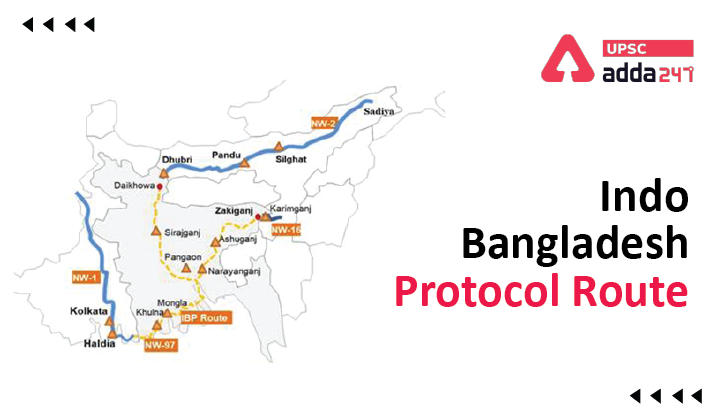Table of Contents
Indo Bangladesh Protocol Route: Relevance
- GS 2: India and its neighborhood- relations.
India Bangladesh Relations: Context
- Recently, Union Minister of Ports, Shipping received the maiden voyage of food-grains from Patna (Bihar) to Pandu (Assam) via Bangladesh.
Indo Bangladesh Protocol Route: Key points
- The self-propelled vessel MV Lal Bahadur Shastri carried a total of 200 MT of food grains for Food Corporation of India (FCI).
- IWAI (Inland Waterways Authority of India) is planning to run a fixed schedule sailing between NW1 and NW2. It will mark a new age of inland water transport for Assam & the Northeast India.
- Another vessel MV Ram Prasad Bismil with two barges Kalpana Chawla and APJ Abdul Kalam started voyage from Haldia on 17th Feb 22 and is on the way to Pandu.
- PM Gati Shakti provided the impetus to rejuvenate the historical trade routes via Bangladesh.
Indo Bangladesh Protocol Route: Significance
- It has marked the beginning of a new age of inland water transport in Assam.
- It would provide the business community a viable, economic & ecological alternative.
- The cargo movement via waterways is going to play a pivotal role in energising India’s northeast as the engine of growth.
- It is in line with the Act East policy of India.
- The waterways will cut through the landlocked access which has been crippling development in the region for long.
- The waterways will not only remove this geographical hindrance, but also provide an economical, swift and convenient transportation for the businesses and people of the region.
About India Bangladesh Protocol Route
- Indo-Bangladesh Protocol on Inland Water Transit & Trade exists between India and Bangladesh under which inland vessels of one country can transit through the specified routes of the other country.
- The existing protocol routes are:
- Kolkata-Pandu-Kolkata
- Kolkata-Karimganj – Kolkata
- Rajshahi-Dhulian-Rajshahi
- Pandu-Karimganj-Pandu
- To improve the navigability, two stretches of IBP routes, i.e., Sirajganj-Daikhowa and Ashuganj-Zakiganj are also being developed at a cost of Rs. 305.84 crore on an 80:20 share basis (80% being borne by India and 20% by Bangladesh).
- The development of these stretches is expected to provide seamless navigation to North Eastern region.
- The contracts for dredging on the two stretches for providing and maintaining requisite depth for a period of seven years (from 2019 to 2026) are underway.
- Once the IBP (India-Bangladesh Protocol) Route no. 5 & 6 from Maia near Farakka in India to Aricha in Bangladesh, the IWT distance connecting NW1 to NW2 (North Eastern Region) will further reduced by nearly 1000 km, which will reduce time and cost to a great extent.





 TSPSC Group 1 Question Paper 2024, Downl...
TSPSC Group 1 Question Paper 2024, Downl...
 TSPSC Group 1 Answer key 2024 Out, Downl...
TSPSC Group 1 Answer key 2024 Out, Downl...
 UPSC Prelims 2024 Question Paper, Downlo...
UPSC Prelims 2024 Question Paper, Downlo...




